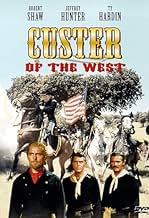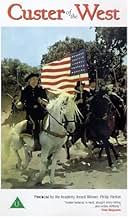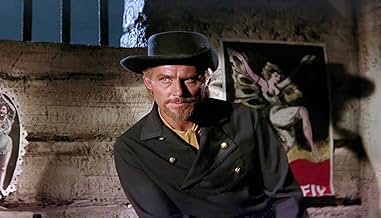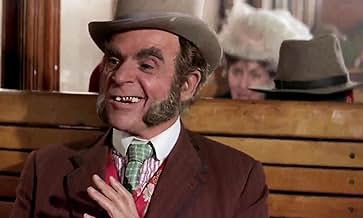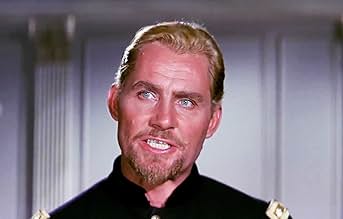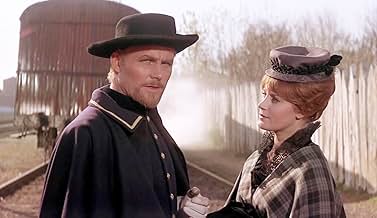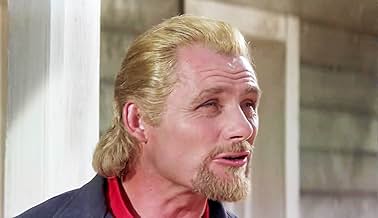NOTE IMDb
5,8/10
1,7 k
MA NOTE
Ajouter une intrigue dans votre langueGeorge Armstrong Custer's love of the heroic traditions of the Calvary and his distaste with the coming of industrialization leads him to his destiny at the Little Big Horn.George Armstrong Custer's love of the heroic traditions of the Calvary and his distaste with the coming of industrialization leads him to his destiny at the Little Big Horn.George Armstrong Custer's love of the heroic traditions of the Calvary and his distaste with the coming of industrialization leads him to his destiny at the Little Big Horn.
- Réalisation
- Scénario
- Casting principal
Avis à la une
I'll make this short and sweet, on second thought, I'll try to! For anyone who has studied history and even scanned a chapter about Custer, could tell that this story line seemed to be made-up as it went along. I have watched this movie only once, and that was more than enough. I understand Hollywoods need to add to, or change charactors or situations to sell a movie. BUT, when they feel the need to give Gen. Armstrong Custer an english accent, Wow!!! Flags went up as soon as he spoke. Ok, ok, overlook that. The thing that gets me the most is the way this movie seems to change the man, to what (I Guess) they wish he was. That too can be overlooked. But, when you change history around to such extremes as, lets pick on the Battle of the Little Big Horn. The way it is acted out is not only corny, but totally oblivious to the truth. The movie has Custer confronting the Indians right before the battle, (According to both versions{The Indians & The Whites} of history, HE DIDN'T).In the movie he didn't flee up the hill(as he did inreal life), away from the village, then finally dismount at almost the top of a hill, surrounded, there to die, and where some mutilations took place.Custer, being the last man standing(YEA, RIGHT!), gets an offer from the chief to let him go, (There was no, I repeat NO SUCH OFFER!) as there was in the movie. Enough you say, there had to be some good. Robert Ryan, in his, much to small a part, was, as usual top notch. However, the story being sooo far fetched ruined it for me. MY RATING: For the valid attept to make a movie,I give 1 Star, Add 1 Star for some decent Charactor Actors, & add 2 for Robert Ryans far too few moments. But, I have to subtract 1 just becaus they thought we wouldn't notice the english accent. 3 Out of 10 STARS
Handsome but dull western (courtesy of Spanish landscapes) to depict Custer on a mission to steal land from the Indians. A blond ROBERT SHAW looks convincing enough on horseback but something about his accent seems wrong and charisma is lacking. The Indians look more European than like American Indians and too many of the action scenes are slow paced and repetitive as Custer and his men go on various missions.
MARY URE as his wife, Libby, has little to do but register impatience with being kept in the background between battles with long waits before she shares the screen with real-life hubby, ROBERT SHAW. A more mature looking JEFFREY HUNTER (sporting gray hairs) is Will Benteen, one of Custer's more loyal officers.
The mountainous plains in Spain are no substitute for our standard glimpses of John Ford territory with not a single shot looking as though photographed in the American West. But it's the dull storyline that defeats the movie from ever becoming anything more than a series of handsomely photographed outdoor sequences. A surprise Indian attack by the Cheyennes on an Indepdence Day Celebration is one of the more colorful moments and triggers Custer's determination to fight the redskins, no matter that they greatly outnumber his men.
Nothing in Shaw's performance suggests the color and vigor of Custer's bigger than life personality nor does the screenplay do any real justice to the man or the myth. As storytelling goes, the first half of the film manages to be just plain dull and the film only picks up speed as it nears the climactic fight at Little Big Horn.
Battle skirmishes with Indians are, on the whole, well staged and full of furious gunsmoke and flying arrows--but the big set piece is saved, of course, for the finale which comes too late to save the first half of the film from the doldrums. One is left with the impression that some inventive fictionalizing would have helped (as it did with THEY DIED WITH THEIR BOOTS ON).
Summing up: A very miscast Shaw plays Custer as a snarling villain who barks orders and the story has a plodding script. Could have been much more impressive if filmed in the U.S. on more realistic locales with more accurate casting. A cameo by ROBERT RYAN is no help at all.
MARY URE as his wife, Libby, has little to do but register impatience with being kept in the background between battles with long waits before she shares the screen with real-life hubby, ROBERT SHAW. A more mature looking JEFFREY HUNTER (sporting gray hairs) is Will Benteen, one of Custer's more loyal officers.
The mountainous plains in Spain are no substitute for our standard glimpses of John Ford territory with not a single shot looking as though photographed in the American West. But it's the dull storyline that defeats the movie from ever becoming anything more than a series of handsomely photographed outdoor sequences. A surprise Indian attack by the Cheyennes on an Indepdence Day Celebration is one of the more colorful moments and triggers Custer's determination to fight the redskins, no matter that they greatly outnumber his men.
Nothing in Shaw's performance suggests the color and vigor of Custer's bigger than life personality nor does the screenplay do any real justice to the man or the myth. As storytelling goes, the first half of the film manages to be just plain dull and the film only picks up speed as it nears the climactic fight at Little Big Horn.
Battle skirmishes with Indians are, on the whole, well staged and full of furious gunsmoke and flying arrows--but the big set piece is saved, of course, for the finale which comes too late to save the first half of the film from the doldrums. One is left with the impression that some inventive fictionalizing would have helped (as it did with THEY DIED WITH THEIR BOOTS ON).
Summing up: A very miscast Shaw plays Custer as a snarling villain who barks orders and the story has a plodding script. Could have been much more impressive if filmed in the U.S. on more realistic locales with more accurate casting. A cameo by ROBERT RYAN is no help at all.
RELEASED IN 1967 and directed by Robert Siodmak, "Custer of the West" is a French/Spanish/American production starring Robert Shaw as the titular hero who becomes the youngest general in the Civil War at 23 and then goes on to fight in the Indian Wars of the northern plains, eventually dying at the Battle of Little Bighorn at the age of 36. Mary Ure plays Custer's wife while Ty Hardin and Jeffrey Hunter play his subordinates Major Reno and Capt. Benteen. Lawrence Tierney is on hand as Gen. Sheridan.
"Custer of the West" both stresses the mistreatment of the plain's Indians by the U.S. and portrays Custer as a tragic American hero who was a puppet of government policy. The film is usually lambasted for its inaccuracies, particularly its depiction of the closing battle. For instance, in real-life Custer's soldiers surprised the Native encampment, they didn't ride up and dialogue with the waiting Indians; moreover, the battle was a chaotic one, moving toward Last Stand Hill. Yet it's not like previous films were any more accurate, e.g. "They Died with Their Boots On" (1941), but audiences apparently demanded more accuracy by the late 60s.
Regardless, the gist of events is true: Reno and Benteen were real-life subordinate officers at odds with Custer and reportedly failed him on the day of battle, although they supposedly had justified cause. If I were Benteen, I would've probably done what he did in the face of Custer's glory-hound rashness and a formidable foe: Dig in, face the enemy, and survive to fight another day. In any case, if you want historical accuracy (to a point) see "Son of the Morning Star" (1991).
The main problem I have with this movie are the Spanish locations substituting for Virginia, the Dakotas and Montana. Fortunately, the creators at least tried to find a setting with trees for Virginia and some of the locations they used for Dakota/Montana occasionally work (just occasionally). But there's a long desert sequence when nothing of the sort exists in the region. You'd have to go far south to New Mexico/Arizona or way further west to eastern Washington to find such deserts. Yet it could be argued that the desert sequence is substituting for the Badlands of the Western Dakotas, which is certainly desert-like.
If you can ignore the disingenuous topographies, there's a lot to appreciate in "Custer of the West." But the film's overlong and bogged down by tedious or useless sequences, like the capture/imprisonment of Sgt. Mulligan (Robert Ryan). But there are some gems, like when Dull Knife (Kieron Moore) pays Custer a visit at the fort (which in real life didn't have a timber stockade). Custer bluntly conveys to the Chief the simple (awful) truth about conquerors and those they conquer: "The problem is precisely the same as when you Cheyenne decided to take another tribe's hunting ground. You didn't ask them about their rights. You didn't care if they had been there a thousand years. You just had more men and more horses. You destroyed them in battle. You took what you wanted and, right or wrong, for better or worse, that is the way things seem to get done. That's history."
FYI: Deviating from the original script, Robert Shaw made the character of Custer over to suit himself, turning him into a "sadist of Shakespearean depth." He also directed the battle scenes with Siodmak staging everything else.
THE MOVIE RUNS 2 hours 21 minutes and was mostly shot 30 miles from Madrid, Spain, except for the Battle of Little Bighorn which was filmed in Costa del Sol near Almira. WRITERS: Bernard Gordon and Julian Zimet with additional work by Shaw.
GRADE: C
"Custer of the West" both stresses the mistreatment of the plain's Indians by the U.S. and portrays Custer as a tragic American hero who was a puppet of government policy. The film is usually lambasted for its inaccuracies, particularly its depiction of the closing battle. For instance, in real-life Custer's soldiers surprised the Native encampment, they didn't ride up and dialogue with the waiting Indians; moreover, the battle was a chaotic one, moving toward Last Stand Hill. Yet it's not like previous films were any more accurate, e.g. "They Died with Their Boots On" (1941), but audiences apparently demanded more accuracy by the late 60s.
Regardless, the gist of events is true: Reno and Benteen were real-life subordinate officers at odds with Custer and reportedly failed him on the day of battle, although they supposedly had justified cause. If I were Benteen, I would've probably done what he did in the face of Custer's glory-hound rashness and a formidable foe: Dig in, face the enemy, and survive to fight another day. In any case, if you want historical accuracy (to a point) see "Son of the Morning Star" (1991).
The main problem I have with this movie are the Spanish locations substituting for Virginia, the Dakotas and Montana. Fortunately, the creators at least tried to find a setting with trees for Virginia and some of the locations they used for Dakota/Montana occasionally work (just occasionally). But there's a long desert sequence when nothing of the sort exists in the region. You'd have to go far south to New Mexico/Arizona or way further west to eastern Washington to find such deserts. Yet it could be argued that the desert sequence is substituting for the Badlands of the Western Dakotas, which is certainly desert-like.
If you can ignore the disingenuous topographies, there's a lot to appreciate in "Custer of the West." But the film's overlong and bogged down by tedious or useless sequences, like the capture/imprisonment of Sgt. Mulligan (Robert Ryan). But there are some gems, like when Dull Knife (Kieron Moore) pays Custer a visit at the fort (which in real life didn't have a timber stockade). Custer bluntly conveys to the Chief the simple (awful) truth about conquerors and those they conquer: "The problem is precisely the same as when you Cheyenne decided to take another tribe's hunting ground. You didn't ask them about their rights. You didn't care if they had been there a thousand years. You just had more men and more horses. You destroyed them in battle. You took what you wanted and, right or wrong, for better or worse, that is the way things seem to get done. That's history."
FYI: Deviating from the original script, Robert Shaw made the character of Custer over to suit himself, turning him into a "sadist of Shakespearean depth." He also directed the battle scenes with Siodmak staging everything else.
THE MOVIE RUNS 2 hours 21 minutes and was mostly shot 30 miles from Madrid, Spain, except for the Battle of Little Bighorn which was filmed in Costa del Sol near Almira. WRITERS: Bernard Gordon and Julian Zimet with additional work by Shaw.
GRADE: C
I won't go on too long about this. It's an efficiently told, largely fictional story of Custer and his last stand, sweetened up for the Whites in the audience and for their children.
It's impossible to imagine an American Indian watching this without feeling nauseous. Kieron Moore as Dull Knife. And at the end Custer seems to be fighting the Cheyenne -- period -- whereas he fought Sioux almost entirely. There were only seven Cheyenne warriors present at the battle. Westerns seem to enjoy dealing with the Cheyenne whenever they need generic Indians. I think it may be the name of the tribe -- The Cheyenne. It's easy to pronounce, and it sounds good. (It means something like "people with red feet" in Cheyenne.) "Sioux," on the other hand, sounds like a girl's name. "Apache" and "Comanche" are euphonious generic names too, but it's hard to get them all the way up to Montana. So what are you left with -- "Paiute"?
I didn't mind Robert Shaw's accent. He's a decent playwright but, regardless of which accent he's using, he can project nothing more than grim determination. When he seems to be enjoying himself, maybe smiling, you can't help feeling that it's calculated, that he's grimly determined to smile. As written, his role doesn't tell us much about Custer. Sometimes he seems brutal and other times, without too much tiresome exposition, he sounds like a liberal. Mary Ure is really appealing, a decent actress, without being staggeringly beautiful, who died an untimely death. Ty Hardin wasn't much of an actor, and he seemed to go politically bonkers after his brief career as a handsome hunky type. Jeffrey Hunter has a small part as the voice of humanitarianism. Lawrence Tierney has a beaut of a New York accent, but it may not be too out of place. Phil Sheridan was from New Jersey, wasn't he? (I may be wrong, but I don't want to bother looking it up.) Robert Ryan is the best actor in the bunch and his part is completely unnecessary, adding nothing to the picture.
The last stand is epic in a way it probably wasn't in real life, if that matters at all. The dead cavalrymen all wind up in something like a circular pile instead of being scattered along the slope up which they retreated. The Indians leave the remains alone, too, instead of violating them as they actually did. (Custer's body was stripped but unmutilated.) Indians tend not to like this kind of movie. On the anniversary of the battle in 1988 they installed a small plaque of crude, angry cast iron commemorating the many Indians who died in the battle. Right in the shadow of the phallic needle that remembers the 7th Cavalry. As it happens, I was living with the Cheyenne as an anthropologist at the time. I have never met a more admirable people. You don't hear much about Indian resentment of White's assumed superiority because they don't shout loud enough. Jane Fonda on her return from France in 1970 found them boring and too fond of alcohol so she went on to more exciting things.
It's impossible to imagine an American Indian watching this without feeling nauseous. Kieron Moore as Dull Knife. And at the end Custer seems to be fighting the Cheyenne -- period -- whereas he fought Sioux almost entirely. There were only seven Cheyenne warriors present at the battle. Westerns seem to enjoy dealing with the Cheyenne whenever they need generic Indians. I think it may be the name of the tribe -- The Cheyenne. It's easy to pronounce, and it sounds good. (It means something like "people with red feet" in Cheyenne.) "Sioux," on the other hand, sounds like a girl's name. "Apache" and "Comanche" are euphonious generic names too, but it's hard to get them all the way up to Montana. So what are you left with -- "Paiute"?
I didn't mind Robert Shaw's accent. He's a decent playwright but, regardless of which accent he's using, he can project nothing more than grim determination. When he seems to be enjoying himself, maybe smiling, you can't help feeling that it's calculated, that he's grimly determined to smile. As written, his role doesn't tell us much about Custer. Sometimes he seems brutal and other times, without too much tiresome exposition, he sounds like a liberal. Mary Ure is really appealing, a decent actress, without being staggeringly beautiful, who died an untimely death. Ty Hardin wasn't much of an actor, and he seemed to go politically bonkers after his brief career as a handsome hunky type. Jeffrey Hunter has a small part as the voice of humanitarianism. Lawrence Tierney has a beaut of a New York accent, but it may not be too out of place. Phil Sheridan was from New Jersey, wasn't he? (I may be wrong, but I don't want to bother looking it up.) Robert Ryan is the best actor in the bunch and his part is completely unnecessary, adding nothing to the picture.
The last stand is epic in a way it probably wasn't in real life, if that matters at all. The dead cavalrymen all wind up in something like a circular pile instead of being scattered along the slope up which they retreated. The Indians leave the remains alone, too, instead of violating them as they actually did. (Custer's body was stripped but unmutilated.) Indians tend not to like this kind of movie. On the anniversary of the battle in 1988 they installed a small plaque of crude, angry cast iron commemorating the many Indians who died in the battle. Right in the shadow of the phallic needle that remembers the 7th Cavalry. As it happens, I was living with the Cheyenne as an anthropologist at the time. I have never met a more admirable people. You don't hear much about Indian resentment of White's assumed superiority because they don't shout loud enough. Jane Fonda on her return from France in 1970 found them boring and too fond of alcohol so she went on to more exciting things.
The film centers around general Custer (Robert Shaw) and wife (Mary Ure), though takes liberties with historical facts . George Armstrong Custer's career begins when is graduated in the known Military Academy of West Point and after that , he intervened in American Civil War where detaches in battle of Gettysburg . General Sheridan (Lawrence Tierney) assigns him the command a regiment at Fort Abraham Lincoln . In 1869 Custer and his 7th Cavalry carried out the massacre of River Washita , where a lot of Indians and their chief Black Kettle were murdered . Later on , Custer takes command a fort and two officers (Jeffrey Hunter and Ty Hardin) will help him to face off Indians with the warring chiefs Dull Knife (Kieron Moore) , Sitting Bull , and Crazy Horse and their tribes Sioux , Cheyenne , the Awpahla and the Munikhanja . The fights go on until the final battle of Little Big Horn (1876) where his entire command was exterminated .
This movie well produced by Philip Jordan blends good action scenes, shootouts , adventures and being quite entertaining , because happen many deeds and fast-moving and that's why it is neither boring , nor dreary, but entertaining . George Armstrong Custer's complex characterization with an unusual point of view is well performed by Robert Shaw who gives a nice embodiment of this Western hero. Robert Shaw's interpretation as a hippie-type, long-haired general , is top-notch , unfortunately he early died , in fact , this is his last film . His wife in the real life, Mary Ure being early dead , as well. The thrilling final confrontation between Custer army and Indians is spellbound and breathtaking similar to ¨ They died with the boots on (1941)¨ with Errol Flynn and directed by Raoul Walsh . The film obtained a limited success in spite of the lavish budget and spectacular sets . Direction by Robert Siodmak is average , in spite of a long career with many cinema classics (Criss Cross , The killers , The spiral staircase , The suspect) and the film is mediocre and overlong , too. The great director Fred Zinnemann even directed some scenes and originally to be directed by Akira Kurosawa, but he ruled out . Cecilio Paniagua's cinematography is glimmering and fascinating and photographed in Super Technirama 70 , the outdoor scenarios are overwhelming , this is the best of the film . Bernardo Segall musical's score is sensitive and moving and performed by Royal Philarmonic orchestra. Splendidly staged battles with obligatory cast of hundreds is well made by the art directors Eugene Lourie and Julio Molina . The motion picture will appeal to biopic enthusiasts and Indians western buffs.
Other adaptations about this historic character culminating in thrilling battle of Little Big Horn are the following ones : ¨Santa Fe trail¨ by Michael Curtiz with Ronald Regan as Custer ; ¨Great massacre Sioux¨ by Sidney Salkow with Philip Carey as Custer and Iron Eyes Cody as Crazy Horse ; ¨Little Big Man¨ by Arthur Penn with Richard Mulligan as Custer ; ¨Son of the morning star¨ TV miniseries by Mike Robe with Gary Cole , among others.
This movie well produced by Philip Jordan blends good action scenes, shootouts , adventures and being quite entertaining , because happen many deeds and fast-moving and that's why it is neither boring , nor dreary, but entertaining . George Armstrong Custer's complex characterization with an unusual point of view is well performed by Robert Shaw who gives a nice embodiment of this Western hero. Robert Shaw's interpretation as a hippie-type, long-haired general , is top-notch , unfortunately he early died , in fact , this is his last film . His wife in the real life, Mary Ure being early dead , as well. The thrilling final confrontation between Custer army and Indians is spellbound and breathtaking similar to ¨ They died with the boots on (1941)¨ with Errol Flynn and directed by Raoul Walsh . The film obtained a limited success in spite of the lavish budget and spectacular sets . Direction by Robert Siodmak is average , in spite of a long career with many cinema classics (Criss Cross , The killers , The spiral staircase , The suspect) and the film is mediocre and overlong , too. The great director Fred Zinnemann even directed some scenes and originally to be directed by Akira Kurosawa, but he ruled out . Cecilio Paniagua's cinematography is glimmering and fascinating and photographed in Super Technirama 70 , the outdoor scenarios are overwhelming , this is the best of the film . Bernardo Segall musical's score is sensitive and moving and performed by Royal Philarmonic orchestra. Splendidly staged battles with obligatory cast of hundreds is well made by the art directors Eugene Lourie and Julio Molina . The motion picture will appeal to biopic enthusiasts and Indians western buffs.
Other adaptations about this historic character culminating in thrilling battle of Little Big Horn are the following ones : ¨Santa Fe trail¨ by Michael Curtiz with Ronald Regan as Custer ; ¨Great massacre Sioux¨ by Sidney Salkow with Philip Carey as Custer and Iron Eyes Cody as Crazy Horse ; ¨Little Big Man¨ by Arthur Penn with Richard Mulligan as Custer ; ¨Son of the morning star¨ TV miniseries by Mike Robe with Gary Cole , among others.
Le saviez-vous
- AnecdotesSome sources have suggested that this was originally to be directed by Akira Kurosawa, but he pulled out. However, this is massively unlikely, given the production history of the film. The more likely explanation is that Kurosawa was approached about directing a different film project on the same subject, "The Day Custer Fell", which was in the works at 20th Century Fox for several years, and for which several Japanese actors famous for working with Kurosawa were approached to play the leading Native American roles. Fred Zinnemann was eventually attached to this project, but it was canceled by Fox because of its ever-escalating budget. "Custer Of The West" was put together very quickly (and made rather cheaply) once this occurred.
- GaffesThe troops of the 7th Cavalry are shown with 1873 Winchester rifles, which were in wide use by 1876, but not by the US Army. Custer's men were armed, as all troopers who did not purchase their own rifles were, with the 1873 Springfield Trapdoor carbine, a single-shot weapon. Had Custer's men been armed with the Winchester, it is possible, though unlikely, that they could have held out until relieved.
- Citations
Gen. Philip Sheridan: You know, you could become a living legend... or get yourself killed. Dead men make better legends.
- Versions alternatives35mm prints released in both complete and shortened versions. Some shortened versions were titled "A Good Day for Fighting".
- ConnexionsFeatured in I Am Not Your Negro (2016)
Meilleurs choix
Connectez-vous pour évaluer et suivre la liste de favoris afin de recevoir des recommandations personnalisées
- How long is Custer of the West?Alimenté par Alexa
Détails
- Date de sortie
- Pays d’origine
- Langue
- Aussi connu sous le nom de
- A Good Day for Fighting
- Lieux de tournage
- Sociétés de production
- Voir plus de crédits d'entreprise sur IMDbPro
Box-office
- Budget
- 4 000 000 $US (estimé)
- Durée
- 2h 20min(140 min)
Contribuer à cette page
Suggérer une modification ou ajouter du contenu manquant

